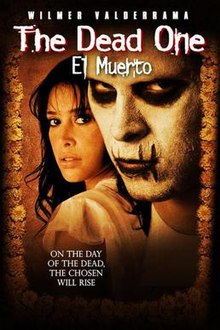
The Day of the Dead is a holiday traditionally celebrated on November 1 and 2, though other days, such as October 31 or November 6, may be included depending on the locality. The multi-day holiday involves family and friends gathering to pay respects and remember friends and family members who have died. These celebrations can take a humorous tone, as celebrants remember amusing events and anecdotes about the departed. It is widely observed in Mexico, where it largely developed, and is also observed in other places, especially by people of Mexican heritage. The observance falls during the Christian period of Allhallowtide. Some argue that there are Indigenous Mexican or ancient Aztec influences that account for the custom, though others see it as a local expression of the Allhallowtide season that was brought to the region by the Spanish; the Day of the Dead has become a way to remember those forebears of Mexican culture. The Day of the Dead is largely seen as having a festive characteristic.

Aztec mythology is the body or collection of myths of the Aztec civilization of Central Mexico. The Aztecs were Nahuatl-speaking groups living in central Mexico and much of their mythology is similar to that of other Mesoamerican cultures. According to legend, the various groups who became the Aztecs arrived from the North into the Anahuac valley around Lake Texcoco. The location of this valley and lake of destination is clear – it is the heart of modern Mexico City – but little can be known with certainty about the origin of the Aztec. There are different accounts of their origin. In the myth, the ancestors of the Mexica/Aztec came from a place in the north called Aztlan, the last of seven nahuatlacas to make the journey southward, hence their name "Azteca." Other accounts cite their origin in Chicomoztoc, "the place of the seven caves", or at Tamoanchan.

Mictlāntēcutli or Mictlantecuhtli, in Aztec mythology, is a god of the dead and the king of Mictlan (Chicunauhmictlan), the lowest and northernmost section of the underworld. He is one of the principal gods of the Aztecs and is the most prominent of several gods and goddesses of death and the underworld. The worship of Mictlantecuhtli sometimes involved ritual cannibalism, with human flesh being consumed in and around the temple. Other names given to Mictlantecuhtli include Ixpuztec, Nextepehua, and Tzontemoc.
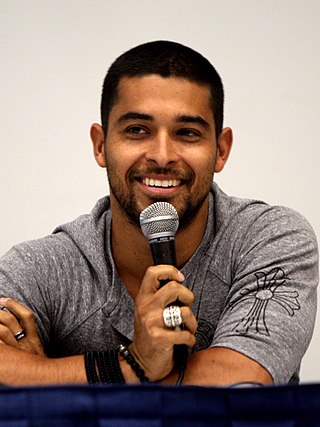
Wilmer Eduardo Valderrama is an American actor. He is known for his role as Fez in the sitcom That '70s Show (1998–2006), his current role as Special Agent Nick Torres in NCIS (2016–present), and Agustín Madrigal in Encanto. He was also host of the MTV series Yo Momma (2006–07), the voice of Manny from the Playhouse Disney/Disney Junior animated series Handy Manny (2006–2013), and played Carlos Madrigal in From Dusk till Dawn: The Series (2014–2016). He has had recurring roles on Grey's Anatomy as well as The Ranch.

In creation myths, the term "Five Suns" refers to the belief of certain Nahua cultures and Aztec peoples that the world has gone through five distinct cycles of creation and destruction, with the current era being the fifth. It is primarily derived from a combination of myths, cosmologies, and eschatological beliefs that were originally held by pre-Columbian peoples in the Mesoamerican region, including central Mexico, and it is part of a larger mythology of Fifth World or Fifth Sun beliefs.
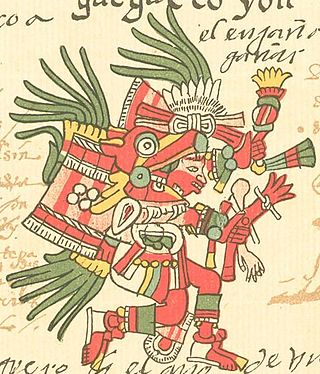
In Aztec mythology, Huēhuehcoyōtl is the auspicious Pre-Columbian god of music, dance, mischief, and song. He is the patron of uninhibited sexuality and rules over the day sign in the Aztec calendar named cuetzpallin (lizard) and the fourth trecena Xochitl.
El Muerto, also known as El Muerto: The Aztec Zombie, is a fictional character and comic book superhero created by American comics creator Javier Hernandez and published through his own imprint Los Comex. The comic book follows the story of 21-year-old Diego de la Muerte, who while on his way to a local Dia de los Muertos festival in Whittier, California, is abducted and sacrificed by the Aztec gods of death and destiny only to return to earth one year later with supernatural powers. The character made his first appearance in a xeroxed black-and-white preview comic titled Daze of the Dead: The Numero Uno Edition. The initial series of El Muerto was met with critical success and the character's popularity has led to several adaptations in other media including a live-action award-winning independent film starring Wilmer Valderrama.

The Aztec religion is a polytheistic and monistic pantheism in which the Nahua concept of teotl was construed as the supreme god Ometeotl, as well as a diverse pantheon of lesser gods and manifestations of nature. The popular religion tended to embrace the mythological and polytheistic aspects, and the Aztec Empire's state religion sponsored both the monism of the upper classes and the popular heterodoxies.

The Condor is a 2007 American animated superhero film based on a character created by Stan Lee. It features the voices of Wilmer Valderrama, María Conchita Alonso, Kathleen Barr, Michael Dobson, Mary Elizabeth McGlynn, and Cusse Mankuma. Originally titled El Lobo, it was released under the Stan Lee Presents banner, which is a series of direct-to-DVD animated films distributed by POW Entertainment with Anchor Bay Entertainment. The story was by Stan Lee, with the script written by former The New Teen Titans writer Marv Wolfman. The film is set in the same world as Mosaic, a prior Stan Lee Presents film, with the film's events apparently occurring before the events of Mosaic. The Condor was released on DVD on March 20, 2007, and had its television premiere on Cartoon Network on March 24, 2007. Since then, the film has been poorly received.
El Muerto is a Spanish term that translates as "The Dead One". It may refer to:
Rafael Navarro is an independent American comic-book artist best known for creating the Xeric Award winning series, Sonambulo, which cleverly blends elements of Lucha Libre and the noir genre. He has collaborated with Keith Rainville and has had work featured in Rainville's From Parts Unknown Publications. Navarro also has experience in storyboarding and has acted as a contributor to several animated television series as Rugrats and ¡Mucha Lucha!. A longtime friend of fellow creator Javier Hernandez, Navarro makes a cameo appearance in the film adaptation of El Muerto: The Aztec Zombie.
Brian Cox is an American writer, director and producer of various independent films and television. He is perhaps best known for the films Scorpion Spring, Keepin' It Real and the live-action adaption of El Muerto: The Aztec Zombie, the latter of which won the Best Feature Film Award at the first annual Whittier Film Festival. One of his first credited roles in film was as a script consultant for the 1990 thriller film Behind Bedroom Doors II.
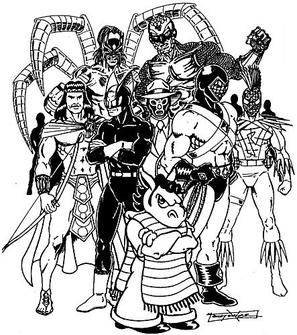
The Professional Amigos of Comic Art Society is a defunct American non-profit organization formed by several independent comic book and cartoon creators in 1995.

There are extensive and varied beliefs in ghosts in Mexican culture. In Mexico, the beliefs of the Maya, Nahua, Purépecha; and other indigenous groups in a supernatural world has survived and evolved, combined with the Catholic beliefs of the Spanish. The Day of the Dead incorporates pre-Columbian beliefs with Christian elements. Mexican literature and cinema include many stories of ghosts interacting with the living.
In Aztec mythology, Creator-Brothers gods are the only four Tezcatlipocas, the children of the creator couple Ometecuhtli and Omecihuatl "Lord and Lady of Duality", "Lord and Lady of the Near and the Nigh", "Father and Mother of the Gods", "Father and Mother of us all", who received the gift of the ability to create other living beings without childbearing. They reside atop a mythical thirteenth heaven Ilhuicatl-Omeyocan "the place of duality".
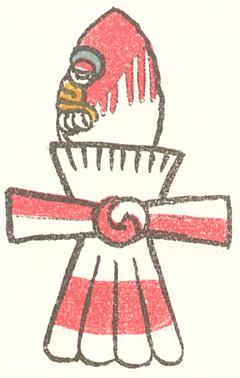
In the Aztec culture, a tecpatl was a flint or obsidian knife with a lanceolate figure and double-edged blade, with elongated ends. Both ends could be rounded or pointed, but other designs were made with a blade attached to a handle. It can be represented with the top half red, reminiscent of the color of blood, in representations of human sacrifice and the rest white, indicating the color of the flint blade.

An ofrenda is the offering placed in a home altar during the annual and traditionally Mexican Día de los Muertos celebration. An ofrenda, which may be quite large and elaborate, is usually created by the family members of a person who has died and is intended to welcome the deceased to the altar setting.

Javier Hernandez is an American artist, comic book creator, and radio host from Whittier, California. Perhaps best known for creating the popular series El Muerto: The Aztec Zombie, the majority of his works are published through his privately owned imprint, Los Comex.

The CMLL Día de Muertos (2014) was a professional wrestling supercard event, scripted and produced by the Mexican Lucha Libre promotion Consejo Mundial de Lucha Libre (CMLL). The show took place on October 31, 2014 in CMLL's main venue, Arena México, in Mexico City, Mexico and celebrated the Mexican Day of the Dead celebration. Many of the wrestlers working the show wore the traditional Día de Muertos face and body paint for the Día de Muerto event. From the fourth match on the losing wrestlers were dragged to El Inframundo, a side entrance in the arena, by a group of wrestlers dressed up as minions of the ruler of the underworld.
